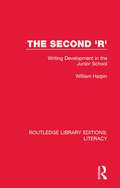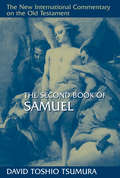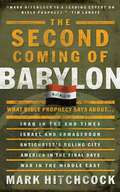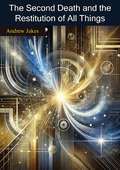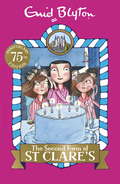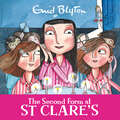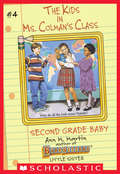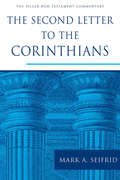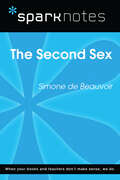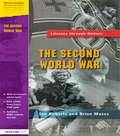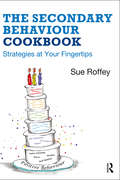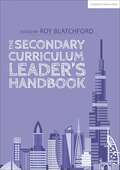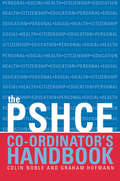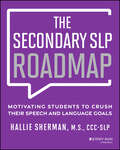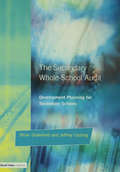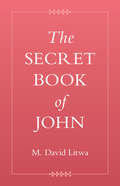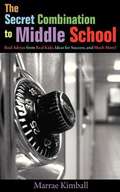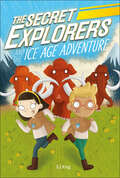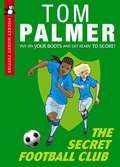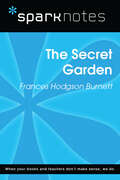- Table View
- List View
The Second 'R': Writing Development in the Junior School (Routledge Library Editions: Literacy #9)
by William Sydney HarpinOriginally published in 1976. How do children learn to write? What stages to they pass through in mastering this skill? What part can teachers play in aiding their development? These are some of the questions that this book sets out to answer. This book offers a perspective on writing which places children's language resources and their development at its centre. It discusses the purpose of writing, ways of classifying its variety, providing contexts for writing, its treatment in schools and methods for helping children to overcome difficulties. A section explores the arguments for a writing policy or programme in schools, and offering guidance on considerations that shape policy making.
The Second Book of Samuel (New International Commentary on the Old Testament (NICOT))
by David Toshio TsumuraSecond Samuel includes some of the most well-known and theologically layered episodes in the Old Testament, such as the Lord&’s establishment of an eternal covenant with David, David&’s sin with Bathsheba, and the subsequent account of Absalom&’s rebellion. In this second part of an ambitious two-volume commentary on the books of Samuel, David Toshio Tsumura elucidates the rich text of 2 Samuel with special attention to literary and textual issues. Tsumura interprets the book in light of the meaning of the original composition, and he provides a fresh new translation based on careful analysis of the Hebrew text.
The Second Book of Samuel (New International Commentary on the Old Testament (NICOT))
by David Toshio TsumuraSecond Samuel includes some of the most well-known and theologically layered episodes in the Old Testament, such as the Lord&’s establishment of an eternal covenant with David, David&’s sin with Bathsheba, and the subsequent account of Absalom&’s rebellion. In this second part of an ambitious two-volume commentary on the books of Samuel, David Toshio Tsumura elucidates the rich text of 2 Samuel with special attention to literary and textual issues. Tsumura interprets the book in light of the meaning of the original composition, and he provides a fresh new translation based on careful analysis of the Hebrew text.
The Second Coming of Babylon: What Bible Prophecy Says About...
by Mark HitchcockThe Bible says that Babylon will be rebuilt and become the economic center of the world. Even now the ruins of the ancient city - just sixty miles south of Baghdad, Iraq - are quietly stirring. What does it mean for America? For Israel? For every person alive today? Are we living in the last days of earth as we know it? Find out, from Bible prophecy expert Mark Hitchcock. 1. How the focus of the world will shift back to Babylon 2. How Antichrist will make Babylon his capital 3. How the kingdoms of earth will fade as Babylon rises 4. How the false powers of Antichrist will grow 5. How prophecy will be fulfilled - and Babylon finally destroyed!
The Second Death and the Restitution of All Things: the Life of Christ and our Universalist Destiny
by Andrew JukesThe Second Death and the Restitution of All Things by Andrew Jukes is a thought-provoking theological work that delves into the profound mysteries of eschatology, exploring the concepts of final judgment, the second death, and the ultimate restoration of all creation. With his characteristic depth and clarity, Jukes offers readers a compelling vision of God's redemptive plan for humanity and the universe.In this seminal book, Jukes examines the biblical teachings on the second death and the restitution of all things, drawing on scriptural passages from both the Old and New Testaments. He challenges traditional interpretations of eternal punishment and proposes a more hopeful and restorative understanding of God's justice and mercy. Through rigorous exegesis and theological reflection, Jukes argues for a view of the second death as a purifying process rather than a final, irrevocable condemnation.Jukes' exploration of the restitution of all things highlights the ultimate reconciliation and renewal of creation, as envisioned in the Bible. He paints a vivid picture of a future where God's love and grace triumph over sin and death, bringing about the restoration of all beings to their intended state of harmony and communion with the Creator. This vision offers a message of hope and assurance, emphasizing the boundless nature of God's redemptive purposes.The Second Death and the Restitution of All Things is an essential read for theologians, pastors, and laypersons interested in eschatology, soteriology, and the broader implications of God's plan for salvation. Jukes' profound insights and eloquent prose provide a fresh and inspiring perspective on the ultimate destiny of humanity and the cosmos.This book invites readers to reconsider conventional views on judgment and redemption, encouraging a deeper understanding of God's infinite love and the transformative power of divine justice. Andrew Jukes' work remains a significant contribution to Christian theology, offering a vision of hope that continues to resonate with believers seeking a more comprehensive and compassionate understanding of God's purposes.
The Second Form at St Clare's: Book 4
by Enid BlytonSchooldays at St Clare's are never dull for twins Pat and Isabel O'Sullivan in Enid Blyton's much-loved boarding school series.In book four, the twins have made it to second form. New girls Gladys and Mirabel have great talents for acting and music, and Elsie, the form's unpopular Head Girl, learns to be less spiteful.Expect more mischief at St Clare's!Between 1941 and 1946, Enid Blyton wrote six novels set at St Clare's. This edition features the original text and is unillustrated.
The Second Form at St Clare's: Book 4 (St Clare's #4)
by Enid BlytonSchooldays at St Clare's are never dull for twins Pat and Isabel O'Sullivan in Enid Blyton's much-loved boarding school series.In book four, the twins have made it to second form. New girls Gladys and Mirabel have great talents for acting and music, and Elsie, the form's unpopular Head Girl, learns to be less spiteful.Expect more mischief at St Clare's!Between 1941 and 1946, Enid Blyton wrote six novels set at St Clare's. This edition features the original text and is unillustrated.
The Second Form at St Clare's: Book 4 (St Clare's #4)
by Enid BlytonSchooldays at St Clare's are never dull for twins Pat and Isabel O'Sullivan in Enid Blyton's much-loved boarding school series.In book four, the twins have made it to second form. New girls Gladys and Mirabel have great talents for acting and music, and Elsie, the form's unpopular Head Girl, learns to be less spiteful.Expect more mischief at St Clare's!(P) 2017 Hodder Children's Books
The Second Grade Baby (The Kids in Ms. Colman's Class #4)
by Ann M. MartinFrom the bestselling author of the generation-defining series The Baby-sitters Club comes a series for a new generation!School is always fun in Ms. Colman's Class!Natalie Springer likes school a lot. But not when the kids call her a baby. Natalie has a chance to do something important in Ms. Colman's class. Her teddy bear is going on a trip around the world! Will Natalie be brave enough to send her teddy so far away?
The Second Letter to the Corinthians (The Pillar New Testament Commentary (PNTC))
by Mark A. SeifridNewest volume in the acclaimed Pillar New Testament Commentary series The question that Paul set before the ancient church in Corinth -- Do you not recognize that Jesus Christ is in and among you? (2 Cor 13:5) -- remains a critical question for the church today. This commentary by Mark Seifrid seeks to hear Paul’s message afresh and communicate it to our time. Seifrid offers a unified reading of 2 Corinthians, which has often been regarded as a composite of excerpts and fragments. He argues that Paul’s message is directed at the “practical atheism” of the Corinthian church -- the hidden heresy that assumes God’s saving work in the world may be measured by outward standards of success and achievement. Like all of the Pillar volumes, Seifrid’s commentary on 2 Corinthians offers careful grammatical analysis and exegesis with clear pastoral application.
The Second Sex (SparkNotes Literature Guide Series)
by SparkNotesThe Second Sex (SparkNotes Literature Guide) by Simone de Beauvoir Making the reading experience fun! Created by Harvard students for students everywhere, SparkNotes is a new breed of study guide: smarter, better, faster. Geared to what today's students need to know, SparkNotes provides: *Chapter-by-chapter analysis *Explanations of key themes, motifs, and symbols *A review quiz and essay topicsLively and accessible, these guides are perfect for late-night studying and writing papers
The Second Testament: A New Translation
by Scot McKnightExperience the New Testament afresh in Scot McKnight's bold translation. Typical translations of the New Testament make the biblical text as accessible as possible by using the language of our own day. At times this masks the distance between the New Testament text and modern readers. Scripture continues to speak to us but it speaks as an ancient text to the modern world. New Testament scholar Scot McKnight offers a translation of the New Testament with a daring approach to the ancient text. Clever in its expression and at times stunning in its boldness, The Second Testament will challenge readers to experience God's Word anew. God blesses the beggars in spirit because theirs is Heavens’ Empire. God blesses the grievers because they will be consoled. God blesses the meek because they will inherit the land. God blesses the ones hungering and thirsting for the rightness because they will be satisfied. (Matthew 5:3-6) Features include: Complete text of the New Testament Brief introductions to each book Maps of key locations and events Glossary of key terms in the translation Full-cloth hardcover with foil stamping
The Second World War: The Second World War
by Ian Roberts Brian MosesThis book will support children as they: * Find out about wartime phrases and use them to write a dialogue * Write a letter home from a P.O.W. camp * Read wartime adverts and slogans and decide how effective they are
The Secondary Behaviour Cookbook: Strategies at Your Fingertips
by Sue RoffeyDeveloped in conjunction with teachers, The Secondary Behaviour Cookbook provides highly effective, practical strategies for responding to and resolving behavioural issues in secondary schools. Consisting of over fifty ‘recipes’, the book’s unique format enables teachers and practitioners to quickly and easily access information and advice on dealing with specific behaviours. Each ‘recipe’ details strategies and interventions for immediate application in the classroom setting, considers possible causes of the given behaviour, and offers helpful approaches for responding to young people’s needs in the longer term. From disorganization and lateness, to attention-seeking and destructive behaviours, bullying, anxiety and depression, the book’s sections cover a broad spectrum of behaviours falling within six broad categories: Getting Things Done: supporting positive student engagement and achievement Dealing with Disruption: increasing motivation and skills to facilitate learning Social Interactions: resolving problematic situations that occur between pupils. Coping with Conflict: addressing conflict in and out of the classroom, including aspects of bullying and discrimination Emotional Distress: understanding distress and developing coping strategies Behaviours of Special Concern: recognising behaviours associated with autism, trauma, abuse or poor mental wellbeing. Underpinned by positive psychology, and emphasising the importance of constructive relationships, communication, inclusion, wellbeing and resilience, this is an indispensable resource for secondary school teachers and educators, behaviour support consultants, SENDCOs and educational psychologists.
The Secondary Curriculum Leader's Handbook
by Roy BlatchfordAt a time of renewed focus on the schools curriculum, Roy Blatchford has brought together some of the sharpest thinkers in education in a brilliant mixture of both practical and conceptual essays about what makes for a positive secondary curriculum.Perfectly timed to reflect the new Ofsted framework, the contributions reflect a range of thinking, planning and delivery, as schools do it now and will for the future. It is a compendium of proven practice, offering tips to less experienced/adventurous middle and senior leaders.Featuring contributions from: Iain Veitch; Deborah Eyre; Stephen Rollett; David Birch; Melanie Saunders; Fran Haynes; Mary Myatt; Rebecca Clark; Nick Soar; Rachel Macfarlane; Ashley Robson; Jo Facer; Ed Vainker; Samuel Strickland; Simon Watson; Elizabeth Swan; Peter Hyman.
The Secondary Curriculum Leader's Handbook
by Roy BlatchfordAt a time of renewed focus on the schools curriculum, Roy Blatchford has brought together some of the sharpest thinkers in education in a brilliant mixture of both practical and conceptual essays about what makes for a positive secondary curriculum.Perfectly timed to reflect the new Ofsted framework, the contributions reflect a range of thinking, planning and delivery, as schools do it now and will for the future. It is a compendium of proven practice, offering tips to less experienced/adventurous middle and senior leaders.Featuring contributions from: Iain Veitch; Deborah Eyre; Stephen Rollett; David Birch; Melanie Saunders; Fran Haynes; Mary Myatt; Rebecca Clark; Nick Soar; Rachel Macfarlane; Ashley Robson; Jo Facer; Ed Vainker; Samuel Strickland; Simon Watson; Elizabeth Swan; Peter Hyman.
The Secondary PSHE Co-ordinator's Handbook
by Colin NobleThis handbook provides the Personal, Social and Health Education (PSHE) co-ordinator in a school with everything that they need to deliver good practice in this subject. The book contains thorough guidance through policy and required practice and has a strongly practical bias. It shows through examples of good practice what can be achieved and how this can generally help to raise standards in schools. This is a topical, lively and up-to-date book which tackles the real issues facing schools, heads, co-ordinators and classroom teachers in an engaging and practical manner. It quotes from examples and case studies where strategies worked, and failed - but also keeps the learning of the pupil as the focus of all activities. The PSHE Co-ordinators Handbook is what every Head and PSHE co-ordinator needs to help them make practical sense of the new curriculum, the new PSHE, the new healthy school standard, social inclusion, citizenship, school councils, and the new Ofsted requirements - and how these can be woven together in a coherent way to support the raising of academic standards.
The Secondary SLP Roadmap: Motivating Students to Crush their Speech and Language Goals
by Hallie ShermanEssential guide for Grade 4-12 SLPs to reduce prep work and help students crush their goals The Secondary SLP Roadmap: Motivating Students to Crush their Speech and Language Goals is a unique resource for speech-language pathologists working with secondary students, who are often harder to motivate and more aware that learning is difficult for them. Based on author Hallie Sherman's 16 years of SLP experience and her extensive professional development training career, this book is filled with stories and practical ideas, tips, and tricks that you can use right away to help students learn more effectively while bringing prep work down to one hour each week. Broken down into three phases to allow for modular learning, this book shows readers how to: Target a variety of goals without spreading resources too thin Work with mixed groups in a way that all students get the attention and assistance they need Teach skills differently than how they are already being addressed in the classroom Build rapport and a safe environment in which students feel comfortable taking risks The Secondary SLP Roadmap provides readers with an essential framework to go from being uncertain and overwhelmed to having their speech students crushing their goals and making massive progress.
The Secondary Whole-school Audit: Development Planning for Secondary Schools
by Brian DrakefordFirst published in 1998. Routledge is an imprint of Taylor & Francis, an informa company.
The Secret Book of John (Coptic Gospels and Associated Texts)
by M. David LitwaIn this volume, David Litwa offers a fresh introduction to the 'gnostic Bible,' arguably the most significant and widely read of all gnostic Christian texts ever written. Providing a fresh introduction to a particular version of the Secret Book of John, namely the shorter version that is found in Nag Hammadi Codex III, his study includes a new translation of this text and an extensive commentary in which he introduces the notable features of this codex and interrogates whether the Secret Book emerged from an actual gnostic community. Litwa also posits solutions to many questions related to this text, notably: its date and find spot, its relationship to the treatise known and summarized by Irenaeus in the late second century, its interpretation and re-creation of the book of Genesis for Christian readers, its novel interpretation of Greco-Roman philosophy, its foundations in apostolic authority, and the reception of the Secret Book of John in late antiquity, well into the fifth century CE.
The Secret Combination To Middle School; Real Advice From Real Kids, Ideas For Success, And Much More!
by Marrae KimballEvery student in middle school should have this book! Although, people of all ages will greatly benefit from reading it. This is the perfect reference guide and all that you will need if you are in middle school or want to succeed in all areas of your life. Get it now and reap the benefits! Middle school is a big change and many times it's the first biggest transition a young person has to face. With any change come uncertainties and questions. There is a huge difference between elementary school and middle school. Students transitioning to middle school tend to experience mixed emotions, being both excited and nervous at the same time. This book will help you rest easy in knowing that you are not alone.
The Secret Explorers and the Haunted Castle (The Secret Explorers)
by SJ KingLearn all about knights and castles in this spooky history-themed instalment of DK Books&’ new educational fiction series for children aged 7 to 9 years old.Meet the Secret Explorers - a band of brainiac kids from all around the world, here to take young readers on a series of fact-filled fictional adventures! Each with their own specialty, from outer space to dinosaurs, these young globetrotters will teach kids that learning can be fun, encouraging them to become experts in something they love. In this fun, fact-filled children&’s book, Kiki the engineering explorer and Gustavo the history expert get caught up in a spooky time travel mystery when a ghostly figure shows up at a medieval castle and terrifies the crowds!This epic adventure is packed with: -Fun facts and illustrations about exciting prehistoric animals-Simple and informative diagrams telling kids all they need to know about castles and knights-Quizzes, mission notes, and a glossary of words with definitionsWith a gripping narrative that keeps kids engaged, The Secret Explorers and the Haunted Castle by SJ King is the perfect gift for children who are into all things history. It&’s written for children aged 7-9 years, with lots of information about medieval knights, castles and ghosts, to give them an exciting introduction into the world of history. At the end of this fictional book, you&’ll find &“Kiki&’s Mission Notes&” which is a summary of all the scientific facts and discoveries made throughout the story. With fun illustrations, quizzes, and a vocabulary list, the educational value of this book is outstanding for a classroom read!Never miss a mission! A total of nine different books, The Secret Explorer series is both educational and imaginative, combining exciting stories with real-life facts. Embark on another space mission adventure in The Secret Explorers and the Comet Collision. Travel back in time to save a dinosaur egg from destruction in The Secret Explorers and the Jurassic Rescue. Take part in a volcano rescue in The Secret Explorers and the Smoking Volcano. Then travel to the arctic for a rescue mission in Secret Explorers and the Missing Scientist.Whatever your preferred topic, there&’s a mission waiting for you!
The Secret Explorers and the Ice Age Adventure (The Secret Explorers)
by SJ KingMeet the Secret Explorers! Children will be inspired to discover the world with these character-driven adventure stories for children aged 7 to 9 years old.Learn all about the ice age and woolly mammoths in this prehistoric-themed installment of DK Books&’ new educational fiction series for children. Meet the Secret Explorers—a band of brainiac kids from all around the world. Everyone in this diverse group of young experts has a specialty, from outer space to dinosaurs, and each story follows a character who gets chosen for a &“secret exploration.&” In this fun, fact-filled children&’s book, Tamiko the dinosaur fanatic and Ollie the rainforest expert travel back in time to the ice age to lead a group of woolly mammoths away from a dangerous avalanche! (More story details to come). Let&’s explore! With a gripping narrative that keeps kids engaged, The Secret Explorers and the Icy Adventure is the perfect gift for children who are into all things nature. It&’s written for children aged 7-9 years, with lots of information about extinct animals and the Earth&’s climate, to give them an exciting introduction to the prehistoric world. At the end of this fictional book, you&’ll find &“Tamiko&’s Mission Notes,&” which is a summary of all the scientific facts and discoveries made throughout the story. With fun illustrations, quizzes, and a vocabulary list, the educational value of this book is outstanding and great for a classroom read!
The Secret Football Club (Pocket Money Puffins)
by Tom PalmerJames, Lily and friends have had some bad news - football is now banned at their school. But they all love football! So if they're not allowed to kick a ball the playground, they'll have to find another way to play - in secret . . .
The Secret Garden (SparkNotes Literature Guide Series)
by SparkNotesThe Secret Garden (SparkNotes Literature Guide) by Frances Hodgson Burnett Making the reading experience fun! Created by Harvard students for students everywhere, SparkNotes is a new breed of study guide: smarter, better, faster. Geared to what today's students need to know, SparkNotes provides: *Chapter-by-chapter analysis *Explanations of key themes, motifs, and symbols *A review quiz and essay topicsLively and accessible, these guides are perfect for late-night studying and writing papers
